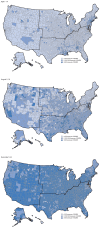Counties with High COVID-19 Incidence and Relatively Large Racial and Ethnic Minority Populations - United States, April 1-December 22, 2020
- PMID: 33793463
- PMCID: PMC8022874
- DOI: 10.15585/mmwr.mm7013e1
Counties with High COVID-19 Incidence and Relatively Large Racial and Ethnic Minority Populations - United States, April 1-December 22, 2020
Abstract
Long-standing systemic social, economic, and environmental inequities in the United States have put many communities of color (racial and ethnic minority groups) at increased risk for exposure to and infection with SARS-CoV-2, the virus that causes COVID-19, as well as more severe COVID-19-related outcomes (1-3). Because race and ethnicity are missing for a proportion of reported COVID-19 cases, counties with substantial missing information often are excluded from analyses of disparities (4). Thus, as a complement to these case-based analyses, population-based studies can help direct public health interventions. Using data from the 50 states and the District of Columbia (DC), CDC identified counties where five racial and ethnic minority groups (Hispanic or Latino [Hispanic], non-Hispanic Black or African American [Black], non-Hispanic Asian [Asian], non-Hispanic American Indian or Alaska Native [AI/AN], and non-Hispanic Native Hawaiian or other Pacific Islander [NH/PI]) might have experienced high COVID-19 impact during April 1-December 22, 2020. These counties had high 2-week COVID-19 incidences (>100 new cases per 100,000 persons in the total population) and percentages of persons in five racial and ethnic groups that were larger than the national percentages (denoted as "large"). During April 1-14, a total of 359 (11.4%) of 3,142 U.S. counties reported high COVID-19 incidence, including 28.7% of counties with large percentages of Asian persons and 27.9% of counties with large percentages of Black persons. During August 5-18, high COVID-19 incidence was reported by 2,034 (64.7%) counties, including 92.4% of counties with large percentages of Black persons and 74.5% of counties with large percentages of Hispanic persons. During December 9-22, high COVID-19 incidence was reported by 3,114 (99.1%) counties, including >95% of those with large percentages of persons in each of the five racial and ethnic minority groups. The findings of this population-based analysis complement those of case-based analyses. In jurisdictions with substantial missing race and ethnicity information, this method could be applied to smaller geographic areas, to identify communities of color that might be experiencing high potential COVID-19 impact. As areas with high rates of new infection change over time, public health efforts can be tailored to the needs of communities of color as the pandemic evolves and integrated with longer-term plans to improve health equity.
Conflict of interest statement
All authors have completed and submitted the International Committee of Medical Journal Editors form for disclosure of potential conflicts of interest. No potential conflicts of interest were disclosed.
Figures


References
-
- CDC. Health equity considerations and racial and ethnic minority groups. Atlanta, GA: US Department of Health and Human Services, CDC; 2020. https://www.cdc.gov/coronavirus/2019-ncov/community/health-equity/race-e...
-
- Moore JT, Ricaldi JN, Rose CE, et al.; COVID-19 State, Tribal, Local, and Territorial Response Team. Disparities in incidence of COVID-19 among underrepresented racial/ethnic groups in counties identified as hotspots during June 5–18, 2020—22 states, February–June 2020. MMWR Morb Mortal Wkly Rep 2020;69:1122–6. 10.15585/mmwr.mm6933e1 - DOI - PMC - PubMed
-
- Council of State and Territorial Epidemiologists. Standardized surveillance case definition and national notification for 2019 novel coronavirus disease (COVID-19). Atlanta, GA: Council of State and Territorial Epidemiologists; 2020. https://cdn.ymaws.com/www.cste.org/resource/resmgr/2020ps/Interim-20-ID-...
MeSH terms
LinkOut - more resources
Full Text Sources
Other Literature Sources
Medical
Research Materials
Miscellaneous

